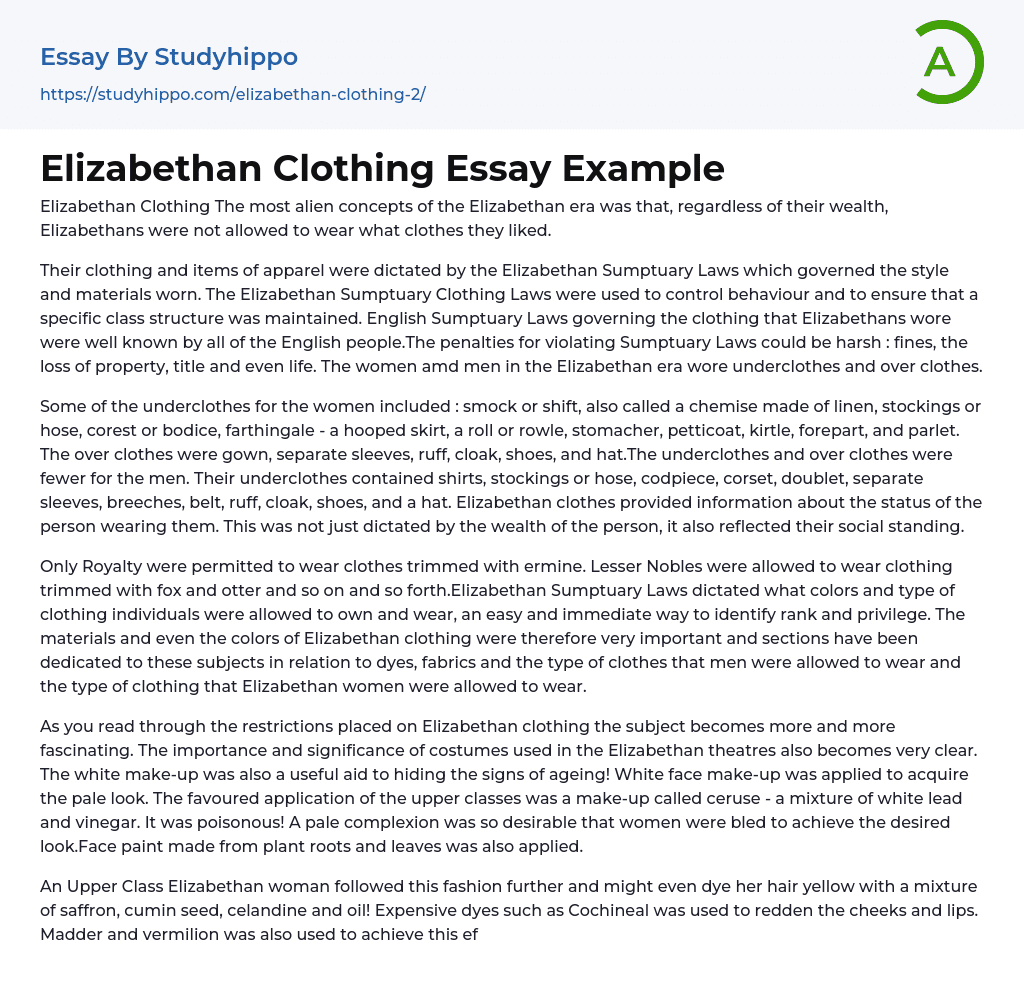One of the most foreign ideas of the Elizabethan period was the restriction on clothing choice based on wealth status.
The clothing and accessories worn by people during the Elizabethan era were subject to regulations known as the Elizabethan Sumptuary Laws. These laws were in place to enforce certain behavior and maintain a specific class structure through dictating the style and materials of clothing worn. It was well known by everyone in England, and punishments for breaking these laws could range from fines to loss of property, title, and even life. Both men and women during this time period wore both underclothes and outer garments.
Within Elizabethan fashion, women's underclothes typically included a linen smock or shift, stockings or hose, a corset or bodice, a hooped skirt known as a farthingale, a roll or rowle, a stomacher, petticoat, kirtle, f
...orepart, and parlet. Over clothes for women consisted of a gown, separate sleeves, a ruff, cloak, shoes, and hat. Men's underclothes were simpler than those for women and usually consisted of shirts, stockings or hose, codpiece, corset, doublet, separate sleeves, breeches, belt, ruff, cloak, shoes, and hat. Fashion during this era was commonly used to indicate the social status of an individual rather than just their wealth.
Elizabethan Sumptuary Laws determined which colors and types of clothing were permitted for individuals to own and wear, making it a straightforward and immediate method of identifying rank and privilege. Only members of Royalty were authorized to wear clothes trimmed with ermine, while Lesser Nobles were permitted to wear garments adorned with fox and otter fur, among others. The choice of fabrics, dyes, and even colors for Elizabethan clothing
was thus highly significant. Consequently, specialized sections have been dedicated to these topics concerning the kinds of clothes that men and Elizabethan women were allowed to wear.
Reading about the limitations on Elizabethan attire is intriguing and sheds light on the significance and value of clothing in Elizabethan plays. It is evident that white make-up was a useful tool for concealing signs of aging. The preferred make-up of the upper class was ceruse, which was a combination of vinegar and white lead, and highly toxic! A pale complexion was so highly sought after that women would even undergo bleeding to achieve it. Additionally, face paint made from plant roots and leaves was also applied.
In the Elizabethan period, affluent women went to great extents in order to keep up with the latest fashion trends. To exemplify, they would use a combination of saffron, cumin seed, celandine and oil to dye their hair yellow. In addition to this, expensive coloring agents such as Cochineal were utilized for reddening both cheeks and lips. Similar effects could also be achieved by using Madder and vermilion. For enhancing eyelashes, Kohl was applied. Queen Elizabeth I was known for owning an extensive collection of wigs and hairpieces amounting to over eighty pieces which were commonly referred to as Periwigs.
- Jeans essays
- Clothing essays
- Cosmetic Surgery essays
- Fashion design essays
- Footwear essays
- Adam And Eve essays
- Baptism essays
- Catholic Church essays
- Christian essays
- Church essays
- Crucifixion Of Jesus essays
- Crusades essays
- Elizabeth essays
- Eucharist essays
- God The Father essays
- Holy Spirit essays
- Jesus Christ essays
- Lord essays
- Pope essays
- Priest essays
- Protestant Reformation essays
- Protestantism essays
- Sacrament essays




